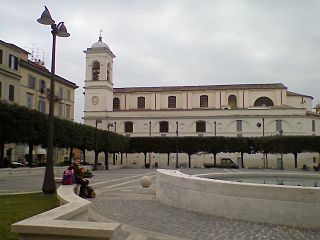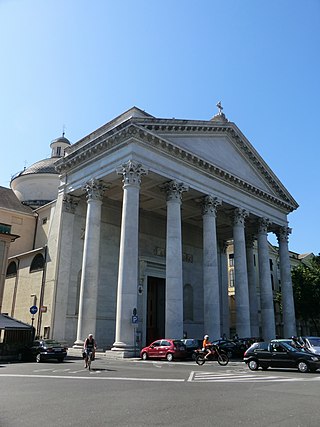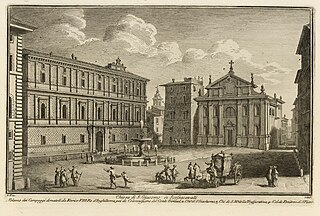Related Research Articles

Philip Romolo Neri, sometimes referred to as the Second Apostle of Rome after Saint Peter, was an Italian Catholic priest who founded the Congregation of the Oratory, a society of secular clergy dedicated to pastoral care and charitable work. Neri's spiritual mission emphasized personal holiness and direct service to others, particularly through the education of young people and care for the poor and sick. His work played a significant role in the Counter-Reformation, especially within the city of Rome.

Santa Maria sopra Minerva is one of the major churches of the Order of Preachers in Rome, Italy. The church's name derives from the fact that the first Christian church structure on the site was built directly over the ruins or foundations of a temple dedicated to the Egyptian goddess Isis, which had been erroneously ascribed to the Greco-Roman goddess Minerva.

The Diocese of Saluzzo is a Latin diocese of the Catholic Church in the Piedmont region of northwestern Italy, centered in the comune of Saluzzo. The diocese was established on 29 October 1511 for political reasons, to transform the Marquisate of Saluzzo into an ecclesiastic territory, and was directly dependent upon the Holy See. It is now a suffragan of the Archdiocese of Turin.

The Diocese of Sabina–Poggio Mirteto is a Latin suburbicarian see of the Holy Roman Church and a diocese of the Catholic Church in Italy in the Roman province of the Pope.

The Diocese of Albano is a Latin suburbicarian see of the Diocese of Rome in Italy, comprising seven towns in the Province of Rome. Albano Laziale is situated on the Appian Way some 15 kilometers from Rome.

The Diocese of Frascati is a Latin suburbicarian see of the Diocese of Rome and a diocese of the Catholic Church in Italy, based at Frascati, near Rome. The bishop of Frascati is a Cardinal Bishop; from the Latin name of the area, the bishop has also been called Bishop of Tusculum. Tusculum was destroyed in 1191. The bishopric moved from Tusculum to Frascati, a nearby town which is first mentioned in the pontificate of Pope Leo IV. Until 1962, the Cardinal-Bishop was concurrently the diocesan bishop of the see. Pope John XXIII removed the Cardinal Bishops from any actual responsibility in their suburbicarian dioceses and made the title purely honorific.

Giovanni Antonio Serbelloni was an Italian Cardinal.

The Diocese of Chiavari is a Latin diocese of the Catholic Church in Liguria, northern Italy. It was created on 3 December 1892 by Pope Leo XIII in the Bull Romani Pontifices. It is a suffragan of the Archdiocese of Genoa.

The 1572 papal conclave, convoked after the death of Pope Pius V, elected Cardinal Ugo Boncompagni, who took the name Gregory XIII.
The Pelagians were a lay confraternity founded in the church of Santa Pelagia in Milan by the seventeenth century Giacomo Filippo di Santa Pelagia, an Italian lay mystic. Although initially approved of by Roman Catholic authorities, the group was later condemned for alleged heretical practices associated with Quietism.

The Brivio de Brokles were a Hungarian and Italian noble family, supposed to be a branch of the more famous Brivio family from Milan.

The Basilica of San Giacomo Maggiore is an historic Roman Catholic church in Bologna, region of Emilia Romagna, Italy, serving a monastery of Augustinian friars. It was built starting in 1267 and houses, among the rest, the Bentivoglio Chapel, featuring numerous Renaissance artworks.

Pietro Paolo Bencini was an Italian Baroque composer and Kapellmeister. He was the father of Antonio Bencini, who was also known as a composer of sacred works.
Quirino Colombani was an Italian composer, and cellist. He was active in both 17th and 18th centuries.

The Oratory of Gesù Pellegrino, also called the Oratorio dei Pretoni, is a Roman Catholic prayer hall or small church found on the corner of Via San Gallo and via degli Arazzieri in Florence, region of Tuscany, Italy.
The Oratory of the Compagnia di Santa Caterina della Notte is a highly decorated prayer hall present in the top floor of the medieval Hospital of Santa Maria della Scala in Siena, region of Tuscany, Italy.

San Giacomo Scossacavalli was a church in Rome important for historical and artistic reasons. The church, facing the Piazza Scossacavalli, was built during the early Middle Ages and since the early 16th century hosted a confraternity which commissioned Renaissance architect Antonio da Sangallo the Younger to build a new shrine. This was richly decorated with frescoes, painted by mannerist artist Giovanni Battista Ricci and his students. The church was demolished in 1937, when Via della Conciliazione was built and the piazza and central part of the Borgo rione were demolished. Many decorative elements still exist, since they were preserved from demolition.
Antonio Altoviti was an Italian Catholic archbishop, son of Bindo Altoviti and archbishop of Florence from 1548 to 1573.

Margherita Panigarola, known by the religious name Arcangela, was an Italian Augustinian nun and mystic.
References
- 1 2 3 4 5 Mauro Regazzoni, "Cinque e Seicento: l'epoca della Riforme e della Controriforma", in Pietro Zovatto (ed.), Storia della spiritualità italiana (Città Nuova, 2002), pp. 233–234.
- 1 2 Querciolo Mazzonis, Spirituality, Gender, and the Self in Renaissance Italy: Angela Merici and the Company of St. Ursula (1474–1540) (Catholic University of America Press, 2007), p. 140n.